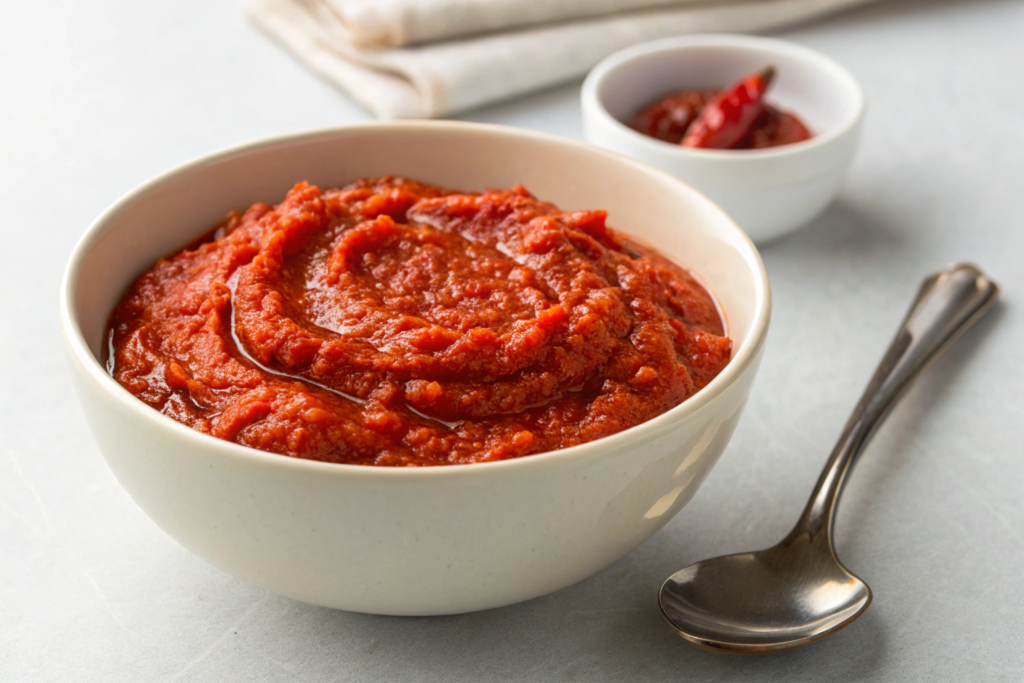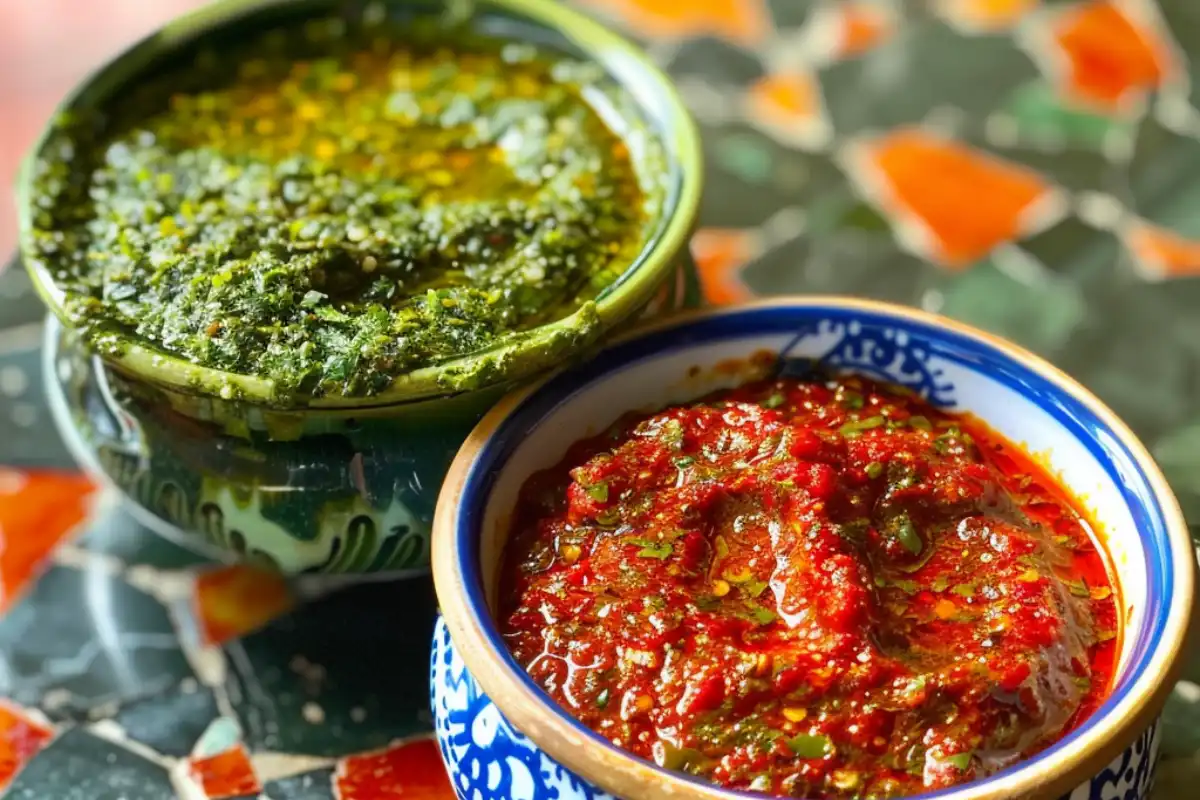Harissa is a flavorful and aromatic chili paste that hails from North African cuisine. Made with a combination of chilies, garlic, spices, and olive oil, it brings both heat and complexity to a wide range of dishes. But is harissa mild or spicy? The answer depends on several factors, including the type of chilies used, the recipe, and how it’s prepared.
In this article, we’ll explore is harissa mild or spicy, what influences its spice level, and how you can adjust its heat to suit your taste. We’ll also provide tips on using harissa in both mild and spicy dishes, making it an indispensable addition to your culinary toolkit.
Table of Contents
What is Harissa?
Harissa is a versatile chili paste originating from Tunisia but used throughout North African and Middle Eastern cuisines. It typically consists of chilies, garlic, spices (such as cumin, coriander, and caraway), and olive oil. The type of chilies used and the preparation methods vary from region to region, leading to different flavors and heat levels.
So, is harissa mild or spicy? Most people associate harissa with a bold, spicy kick, but not all harissa delivers the same level of heat. Some versions emphasize the aromatic qualities of the spices and herbs, creating a milder flavor, while others pack a fiery punch.
The Flavor Profile of Harissa

Harissa’s flavor profile is both complex and bold, combining spicy, smoky, earthy, and tangy elements. This unique blend of flavors makes it a popular choice for adding depth to a wide variety of dishes.
Key Components of Harissa’s Flavor:
- Heat: The main component of harissa is its chilies, which provide varying degrees of spice depending on the type used.
- Garlic: Provides a pungent, savory backbone that complements the heat.
- Spices: Cumin, coriander, and caraway add warmth and an earthy, aromatic quality to the sauce.
- Acidity: Some versions include lemon juice or vinegar, which cuts through the richness of the chilies and olive oil, adding brightness.
- Smokiness: Depending on the chilies used, particularly if they are dried or roasted, harissa can have a smoky depth that balances the heat.
These components influence is harissa mild or spicy, giving each variation its unique taste.For more details about what goes into harissa and its rich flavor profile, check out What Is Harissa Made Of?, which offers an in-depth exploration of this North African staple.
What Makes Harissa Spicy or Mild?

The heat level of harissa largely depends on the type of chilies used, as different varieties carry different levels of heat, measured on the Scoville scale.
1. Type of Chilies Used
Different chilies have different heat levels:
- Anaheim Chilies (500–2,500 Scoville units): Mild, creating a harissa with gentle heat.
- Serrano Chilies (10,000–23,000 Scoville units): Moderately spicy.
- Bird’s Eye Chilies (50,000–100,000 Scoville units): Quite hot, making for a significantly spicier harissa.
- Habanero Chilies (100,000–350,000 Scoville units): Extremely hot.
Choosing mild or hot chilies determines is harissa mild or spicy in your recipe. If you’re curious about how this scale works, check out this guide on Understanding the Scoville Scale: Measuring Chili Heat.
2. Fresh vs. Dried Chilies
- Fresh Chilies: Give harissa a more vibrant, slightly milder taste.
- Dried Chilies: Tend to be more concentrated in flavor, leading to a spicier and smokier harissa.
3. Seeds and Membranes
The seeds and membranes of the chilies contain most of the heat due to high concentrations of capsaicin, the compound responsible for spiciness. Removing the seeds and membranes can significantly reduce the heat level, making the harissa milder. Conversely, leaving them in results in a much spicier sauce.
4. Additional Ingredients
You can control the heat in harissa by adding ingredients like yogurt, tahini, or olive oil. These ingredients mellow the heat, creating a milder and creamier paste. Additionally, including citrus elements like lemon juice or vinegar helps balance the richness of the chilies, adding a bright contrast to the heat.
Mild Harissa: What to Expect
Mild harissa offers the signature flavors of the paste without overwhelming heat.
How to Use Mild Harissa
- Spreads and Dips: Combine mild harissa with Greek yogurt to create a creamy, tangy dip for vegetables or pita bread.
- Salad Dressings: Mix mild harissa with olive oil and lemon juice for a flavorful, mildly spicy salad dressing.
- Grain Bowls: Add a spoonful of mild harissa to grain bowls made with quinoa, farro, or couscous to enhance the flavor without making the dish too spicy.
Using milder chilies or balancing the spice with other ingredients determines is harissa mild or spicy in different recipes.
Spicy Harissa: Turning Up the Heat
For those who love intense heat, spicy harissa is the perfect choice.
How to Use Spicy Harissa
- Marinades: Perfect for grilled meats like chicken and lamb.
- Soups and Stews: Adds warmth and depth to North African dishes.
- Roasted Vegetables: Enhances flavors with a smoky, spicy kick.
Harissa’s versatility allows customization, making is harissa mild or spicy dependent on personal preference.
For more recipe ideas using mild harissa, check out our post on What Do You Do with Green Harissa?, which offers tips on balancing flavors in different types of dishes.
Adjusting the Spice Level in Homemade Harissa
Making Harissa Milder
- Remove the seeds from the chilies.
- Use mild chilies like Anaheim.
- Mix with yogurt or olive oil.
Making Harissa Spicier
- Keep the seeds in.
- Use hotter chilies like Habanero.
- Add chili flakes or cayenne.
These adjustments let you control is harissa mild or spicy to suit your taste.
So, is harissa mild or spicy? The answer varies based on ingredients, preparation, and personal preference. Whether you enjoy a subtle heat or a fiery kick, harissa offers a depth of flavor that enhances any dish. Understanding these factors allows you to tailor harissa to your liking, making it a must-have in your kitchen.
FAQs About Is Harissa Mild or Spicy
1. Is harissa always spicy?
- Not always. Some versions focus more on the herbs and spices, creating a milder flavor.
2. Can you make harissa less spicy?
- Yes, by using milder chilies, removing the seeds, or mixing it with yogurt or olive oil.
3. Is harissa spicier than sriracha?
- It depends. Some harissa varieties can be spicier, while others are milder than sriracha.
4. How can I tone down store-bought harissa?
- Mix it with Greek yogurt, olive oil, or lemon juice.

